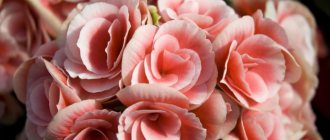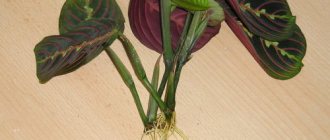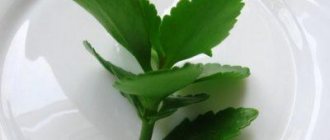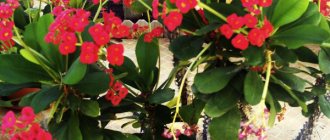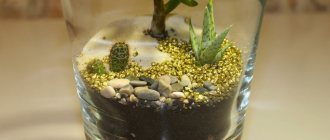Origin and appearance of the plant
Crossandra is a deciduous shrub from the Acanthaceae family. Homeland - India. It also grows in the tropics of Africa, Madagascar, and the Arabian Peninsula.
The shoots are straight, branched, brown-violet (almost black) or green. The height of the plant trunk in the wild is about a meter. The leaves are ellipsoid, with a rounded end, shiny, dark green, up to 9 cm long. The flowers are collected in spike-shaped inflorescences with 4 edges up to 15 cm in length. They open one by one, from bottom to top. There are yellow, orange, red shades.
Crossandra is an evergreen shrub with beautiful flowers.
Crossandra has the ability to scatter seeds over fairly long distances from the plant itself. For this property, as well as for its abundant unusual flowering, the plant is called “fireworks of flowers.”
Features of Crossandra
Crossandra is a subshrub that can reach 0.3–0.5 m in height. Its glossy bare opposite leaf blades have a pointed tip at the top and a dark green color; they can be wavy to varying degrees along the edge, and reach a length of 7 to 12 centimeters. During flowering, an axillary dense inflorescence in the shape of a tetrahedral spike is formed. The flowers reach about 2.5 cm in diameter and are salmon-colored. This plant is a very close relative of such crops as: pachystachys, aphelandra and ruellia.
#Houseplant Crossandra is a Ceylon beauty. Care, cuttings.
Crossandra Fortuna and other popular home varieties
It is possible to grow crossandra at home, but following all the rules of care. There are more than 50 plant species in nature. The most common variety in home keeping is funnel-shaped.
- Funnel-shaped (wavy-leaved, orange). It appeared in European greenhouses back in the 19th century. At home, the bush grows up to 50 cm in height. The diameter of the flowers is 2–3 cm. The corolla is bright orange.
Based on the funnel-shaped crossandra, other domestic hybrids were bred.
- Hybrid Fortuna . This favorite of flower growers appeared not so long ago. Salmon-orange flowers, a strong root system, resistance to temperature changes (tolerates drops of up to 10 °C), and a longer life span are the distinctive features of the variety.
- Prickly . A plant with bright yellow flowers and decorative variegated leaves with silver veins.
- Nile (red) . Red or pink flowers are collected in short inflorescences.
- Guinean . Quite rarely cultivated at home. Compact plant (up to 20 cm in height) with short-petioled leaves. Spike-shaped inflorescences consist of pale lilac or white flowers.
Photo gallery: types of crossandra
Fortuna is a long-liver among crossanders
Nile crossandra is also called red
Funnel-shaped crossandra is the most common variety for home cultivation.
Prickly crossandra has yellow flowers
Sometimes there is also a plant with blue flowers, erroneously called crossandra blue (turquoise) . Although this flower looks similar to its relatives from the Acanthaceae family, it actually belongs to the genus Ecbolium (unlike Crossandra, Ecbolium has 1-2 flowers in an inflorescence).
Ecbolium, unlike crossandra, has only 1–2 flowers in an inflorescence
Video: Meet Crossandra
3.Varieties:
3.1. Funnel-shaped or wavy-leaved crossandra - Crossandra infundibuliformis
A green tropical shrub, native to South India and Sri Lanka, reaches a height of 30 - 90 cm, has abundantly branched, erect stems. The leaves are dark green, glossy, lanceolate, reaching a length of 5 - 10 cm. The flowers are collected in small apical inflorescences and have asymmetrical petals of yellow, orange, salmon, coral, and red. flowering can occur at any time of the year.
↑ Up,
3.2.Crossandra funnel-shaped Fortuna - Crossandra infundibuliformis 'Fortuna'
Perennial evergreens with very abundant and long-lasting flowering. It has glossy, green, lanceolate leaves with branched veins slightly recessed into the leaf blades. It develops very quickly. During the flowering period, short peduncles are released at the tops of the stems, which bear bright, orange flowers.
↑ Up,
3.3. Crossandra pungens
Evergreen plants that can safely be classified as both decorative deciduous and flowering. This type of crossandra is often grown as a ground cover plant. The bushes have erect stems with long, lanceolate, dark green leaves. On the surface of the leaf plates, leaf veins are highlighted with a silvery tint. Leaves collected in whorls. During the flowering period, large inflorescences with delicate, cream or yellow flowers appear at the tops of the stems.
↑ Up,
Nuances of care
Watering
Crossandra should be watered generously, but not flooded. Balance is very important here . A sign for the next watering is a slightly dried out top layer of soil. You need to use soft water that has been standing for at least a day; if possible, use rain water. You cannot pour water on leaves and flowers - only on the soil.
Top dressing
Feeding crossandra is a prerequisite for good development and flowering of the plant. In the spring-summer season, the flower is fertilized 3-4 times a month with a balanced mineral fertilizer (for example, Uniflor or POKON). After fertilizing, watering is necessary. By the end of September, feeding is stopped.
Fertilizing for crossandra is a necessary condition for the development of the plant
Pruning and flowering period
After a dormant period in early spring, the shoots of the plant are cut off by half. The crown begins to branch, young shoots are also pinched - this leads to an increase in the number of flowers. Crossandra blooms from May to September . For flowering, bright, diffused light is required. The plant produces the strongest and most numerous flowers in the 2nd–4th year of life.
Caring for crossandra at home
Our tropical beauty loves warmth, high humidity and close proximity to other tropical flowers. It is non-toxic and poses no danger to humans or pets. But, we’ll tell you about everything in order.
Location and lighting
Crossandra requires a lot of sunlight. It will grow well and bloom luxuriantly on all windows facing south. In summer, young bushes are best protected from the midday sun with light curtains or blinds.
Let us add that crossandra is a social flower. She really loves the close company of tropical flowers like her. These can be ferns, arrowroots, begonias, calatheas, fittonias, i.e. the same lovers of tropical microclimates. In the summer, these flowers can be taken outside a glazed balcony or a closed but well-lit veranda and create a real jungle there. You should not take plants into the garden or flowerbed near the house, as any wind or rain can greatly harm them.
In winter, it is best to place the flower on a southern windowsill, since the sun's rays will not cause any harm to the plant. If there is insufficient lighting, the crossandra will bloom poorly. Therefore, if necessary, organize artificial lighting for it in the autumn-winter period.
Temperature
The tropical flower is suitable for the year-round temperature of our apartments: 18-28 °C. In summer, it is advisable that the temperature does not exceed 30 °C, and in winter it does not fall below 15 °C. Some crossandra varieties are more cold-resistant and can withstand short-term cold snaps. The flower does not like sharp fluctuations in temperature and drafts, take this into account when ventilating your home.
Watering
Proper watering plays a big role in maintaining the decorative appearance of a flower. Crossandra is very sensitive to both waterlogging of the soil in the pot and drought. Never water a flower before the top layer of soil has dried, but you should not completely dry out the earthen ball.
If you forget to water a flower on a summer day, in the evening you will see its leaves wither and droop. Urgent resuscitation of the flower will be required. Fill a basin with settled water at room temperature and place a pot of crossandra in it. Let it sit there for about an hour or a little more until it straightens out its leaves again. Now you need to remove the pot from the basin and wait until the water drains. Only after this can the flower be returned to its original place.
If a dehydrated crossandra stands without watering for a day, it will die!
For irrigation, use only settled or filtered water at room temperature. In the summer, water the plant more abundantly than in spring and autumn. If the plant does not bloom, it also requires less moisture. In winter, watering should be moderate, approximately once every 2 weeks.
Air humidity
Crossandra came to us from the hot and humid tropics. It needs high ambient humidity, from 70% and above in a hot room, and 50-60% in a cool room. You will have to work hard to create tropical-like conditions in your apartment. To do this, you can use a regular sprayer, a household humidifier, an aquarium and other containers with water to evaporate moisture, deep trays with wet moss or expanded clay, in which a pot with crossandra is placed during especially hot and dry periods of its life. The hotter it is in the room, the more often the leaves should be sprayed, without getting the stream of water on the buds and inflorescences.
In addition, the plant does not tolerate gas combustion products. He needs fresh air. Therefore, be sure to ventilate the room. At this time, take the pot with crossandra into another room, since it also does not like drafts.
Feeding
During active growth and flowering, crossandra should be fed with liquid mineral fertilizers for flowering plants. Once every ten days is enough. Such fertilizing can be alternated with organic fertilizers. Immediately after transplantation, for a couple of months, there is no need to feed the flower. During winter rest, fertilizing is also not required.
When to prune crossandra
The best time to prune crossandra is in the fall, after flowering. They cut it off radically: cut out excess branches (broken, dry, thin, thickening the bush or sticking out to the sides). Shoots that are too long are also cut to the required length, but no more than a third. A healthy plant will definitely grow new young branches in the spring.
This may be interesting: Diseases of violets and their treatment
In spring, only dry and weak branches are pruned, most importantly, before the buds open.
To prevent crossandra stems from stretching and becoming bare, regularly pinch the tops of the shoots. We also recommend pinching young plants for better branching.
Do not forget to remove faded flowers in a timely manner.
Bloom
In the wild, crossandra blooms all year round. But at home, it blooms from May to September, because with large temperature fluctuations and less intense lighting, flowering requires too much effort. And to replenish them, the crossandra needs a full winter rest.
The flowers are odorless, tubular, asymmetrical, collected in spikelets. The color of leaves and inflorescences depends on the variety. But they are all amazingly beautiful. We have analyzed all the popular types and varieties of crossandra in the article at the link . Each flower stays on the plant for an average of several days.
By pruning, you can slightly prolong the flowering of the bush. If you cut off the spikelet as soon as its top has withered, the plant will produce a new peduncle.
After flowering, fruits are formed in the form of capsules with seeds. When the capsules ripen, when water hits them, they burst and scatter the seeds over a distance of up to 3 meters.
Rest period
In the wild, Crossandra has no rest period. There it grows and blooms all year round. But in our latitudes her habits have changed. With the onset of short cool days in autumn, crossandra slows down its growth and development and prepares for “hibernation.” You will have to properly organize rest conditions for her: reduce watering to a minimum, stop fertilizing, reduce the room temperature to 16-18 ° C and, accordingly, humidity to 50-60%. Instead of spraying, wipe the leaves with a damp cloth. But it is advisable to continue to maintain the length of daylight hours by organizing additional lighting with LED or phyto lamps.
At the end of wintering, in February - early March, before the buds are laid, put the crossandra bush in order - carry out rejuvenating sanitary pruning of weak, broken and elongated branches. Trim or pinch healthy shoots to about 2 inches above a pair of leaves. Then the crown will become more magnificent due to the fact that there will be more tops, and therefore inflorescences.
Reddening and falling leaves, blackening stems and other problems
Why is your crossandra losing its attractiveness? There are two answers to this question: either you violate the rules of cultivation and care, or the flower has been damaged by a disease or attacked by a pest.
Table: care errors and how to correct them
| Problem | Possible reason | What to do |
| Leaves curl and fall |
|
|
| The leaves are turning yellow |
|
|
| Green leaves are falling |
|
|
| The plant does not bloom |
|
|
| The tips of the leaves dry out | Low air humidity. |
|
| Brown spots on leaves | Sunburn. |
|
| Leaves turn red (black) and fall off | This is a natural process of leaf aging. | — |
| The leaves lighten and fade |
|
|
Crossandra: what pests threaten the plant
In this chapter, we will analyze the problems associated with attacks by harmful insects and suggest options for getting rid of them.
- Drying, curling and falling of leaves. Here and there yellowish spots and dots appeared, with white cobwebs. It is related to spider mites . A systemic insecticide (Fitoferm, Actellik, Derris), or more precisely, spraying, will help here. As a preventative measure, inspect the plant to detect the first signs of pest attack. It is also necessary to keep the leaves clean: spraying or wiping with wet wipes. Humidifying the air and ventilating the room will also help. Spider mites love dry and stuffy rooms.
- Curling of young shoots, leaves and peduncles. Typically, if you look closely, you can see tiny insects. This is an aphid. The fight against it should begin by removing seriously affected areas. Then wash the bush with a warm shower, and after drying, treat it with any aphid preparation containing permethrin.
- The growth of the plant is severely inhibited against the background of limp and dull leaves, whitish small lumps and a sticky coating. This is an attack by a mealybug , sucking out all the juice from the plants. The first thing to do is isolate the plant. This will help protect companion plants, since the scale insect quickly infects neighboring plants. Next, remove the pest using a damp cloth or rinse under running water. Spraying or washing with a soap-alcohol solution will also help (hot water - 1 liter, laundry soap - 20 g, alcohol - 20 ml). In case of mass damage, treatment with insecticides (Fufanon, Aktar, Aktellik) cannot be avoided.
- The underside of the leaves is full of greenish larvae, the bush is full of flying small insects. This is a whitefly attack. Start by removing the affected leaves. Next, you should wash the bush under running warm water, thus removing most of the harmful insects. Then it is necessary to treat the above-ground part of the plant and soil using the Aktar solution (see instructions). It may take several treatments to finally get rid of this prolific pest. You can also spray the crossandra with Confidor against whiteflies, covering it with polyethylene overnight. True, this drug smells strongly, so it would be a good idea to take care of it outside the home (utility room).
Planting and transplanting
After purchase, if there are no flowers on the crossandra, it should be replanted immediately, and if it blooms, after flowering has ended. A young plant needs to be replanted annually, and adults (after 4 years of age) - once every 2-3 years. Transplantation is carried out in early spring, until the flower begins to grow.
The soil for crossandra should be nutritious, loose and light . You can compose it yourself by taking turf, leaf soil, peat and humus in equal proportions, adding sand (10% of the total mass), or use ready-made soil for azaleas.
The pot is needed a little wider than the previous one, with drainage holes.
Procedure:
- Pour drainage into the bottom of the container (at least a quarter of the height of the pot), then a small layer of new soil.
- Carefully remove the plant from the old pot along with the earthen lump.
- We inspect the roots, cut off the rotten areas along with the soil with a sterile knife and sprinkle with crushed activated carbon.
- Place the earthen ball with the flower in the center of the pot and fill the resulting gaps with soil.
- Lightly compact the soil around the plant.
- We water it.
Pruning crossandra shoots: how to trim a houseplant
After the end of the flowering period, the shoots are pruned, the temperature decreases slightly and a dormant period begins. Before pruning your homemade crossandra, you need to determine what appearance the plant should have, arm yourself with pruning shears and cut off long cuttings. In addition, you need to remove all dried branches, leaves and faded inflorescences.
The dormant period will last until the beginning of February, and then again you need to trim the crossandra shoots by about a third of their length and create a beautiful crown. Along with shortening long shoots, they are also pinched. This action will give the plant the opportunity to release lateral shoots, and the ornamental bush will become lush and elegant.
Watch a video about caring for crossandra, which clearly shows all the steps for replanting, pruning and forming a bush:
Reproduction
Cuttings in summer
The best option for propagating crossandra is by cuttings. The best time for rooting is summer, but in the spring they also take root.
Progress:
- Place the cut apical stalk 10–15 cm long in a glass of water.
- After 3-4 weeks, roots will appear.
When roots appear, the cuttings can be planted in the substrate
- Transplant the cuttings with roots into the ground (soil composition: turf, leaf, peat soil and humus).
After the roots appear, the crossandra is planted in a separate pot with nutritious soil.
- Maintain the temperature no lower than 20–22 °C.
Seeds
The method of growing crossandra from seeds is used quite rarely. It is better to plant seeds freshly harvested; with long-term storage, their germination time increases significantly.
Procedure:
- Soak the seeds in water for several hours.
Crossandra seeds require soaking in water - Optimal soil: peat and coarse sand in equal proportions.
- Plant the seeds in a container, cover with film, maintain the temperature at 22–24 oC.
- Ventilate the greenhouse every day and wipe off condensation with a rag. Water moderately to avoid rotting.
- Sprouts will appear in 2–3 weeks.
- A month after germination, transplant the seedlings into pots with a diameter of about 6 cm.
The time of emergence of sprouts depends on the degree of “freshness” of the crossandra seeds - After another month, pinch the tops of the seedlings and transfer them to a larger pot with soil and drainage, like an adult crossandra.
Replanting a fireworks flower
Crossandra doesn't really like change. The plant takes a long time to get used to a new pot, may delay flowering, twist and shed its leaves. Therefore, a flame flower is replanted if the roots have entwined the entire ground and look out from below; growth has slowed down due to the fact that the soil is depleted. Then move the crossandra in the spring. Do the transshipment, preserving the earthen lump as much as possible.
The new crossandra pot should be only slightly larger than the old one
The next pot for crossandra must be selected 2–3 cm wider in diameter than the previous one. She doesn't need an extensive one. In a large volume of soil, it will grow roots, then the above-ground part, and flowers will appear later or not appear at all. A large pot will retain water, which can lead to rotting of the root system. The material from which the container is made is not so important for crossandra. Both plastic and ceramics are suitable for her. And the number and diameter of holes for drainage are important. The more there are, the better. Excess water should drain easily from the soil.
A crossandra pot must have a drainage layer.
Prepare crossander soil that is porous and moderately fertile, neutral or slightly acidic. For example, plant it in universal soil, you can add a little coarse sand or chopped moss. Or try making a soil mixture according to one of the recipes:
- mix leaf and turf soil, coarse sand equally, add vermiculite or a little broken brick;
- two parts of leaf and turf soil, half of coarse river sand and humus;
- 2 parts of any soil for indoor plants, 1 each of vermiculite and soil for succulents;
- two parts each of leaf and peat soil, add turf soil and sand one part each.
For drainage, you can use expanded clay, small pebbles, or crushed bricks (necessarily red).
Crossandra transplant
- Prepare and steam or heat the soil mixture, drainage, and pour boiling water over the pot.
- Place drainage at the bottom, and part of the soil on top of it.
- Two or three days before transplanting, stop watering the crossandra so that the soil dries out, this will make it easier to remove and save the earthen lump.
- Remove the crossandra from the container, separating the soil from the walls with a knife or spatula, and inspect the roots.
- Cut off rotten and dry ones. Clear several outer shoots from the soil.
- Treat the root system with growth stimulants (Epin, Zircon).
- Place the crossandra earthen ball in a new pot, straighten the loose roots.
- Carefully fill the gap between the lump and the walls with new soil.
- Compact it gradually, being careful not to touch the roots.
- Water the plant and spray its crown. Humidity helps you settle in faster.
- Place the transplanted crossandra in its usual place.
After the purchase
If you bought a flowering crossandra, wait to replant until the inflorescences wither. And then try to replace almost completely the soil. Save only the one that sticks tightly to the roots. To stimulate flowering, crossandra can be treated with special preparations, which are not always useful, so it is better to replant it in fresh soil.
Replant the flowering crossandra that you brought from the store after the inflorescences wither
Replant the crossandra purchased without flowers in 1–2 weeks. Moving from a store is stressful, and so is transplanting. Let the flower get used to its new home.
Possible problems in growing
Dieffenbachia - home care, reproduction
When growing crossandra indoors, gardeners periodically encounter certain problems that require competent and timely solutions.
The leaves are turning red
The leaves of the flower often begin to turn red due to excess sunlight. To protect the plant, you need to create a little shade for it at midday (you can simply set the pot aside or hang a light curtain). Also, a red leaf can signal a lack of nutritional components in the substrate.
Leaves are drying
Sometimes the leaves of indoor crossandra begin to turn yellow and dry out for no apparent reason. Such symptoms are often accompanied by the appearance of cobwebs and yellowish spots on the leaves. Spider mites can cause such consequences. The plant urgently needs to be treated with a systemic insecticide (Fitoverm or Actellik are suitable). For preventative purposes, the leaves are regularly sprayed and wiped with a damp cloth. Spider mites actively reproduce in dry and poorly ventilated areas.
Dried leaves often signal the negative impact of pests
The flower doesn't bloom
There may be several reasons why homemade crossandra does not bloom. These include:
- Planting in a large pot, as a result of which the root system takes a long time to fill the free space.
- In winter, the plant did not have a rest period, so in summer it does not have the strength to flower.
- There is a deficiency of nutrients or an excess of nitrogen in the soil, as a result of which the green mass is actively growing.
- The crossandra was not pruned in time, so it did not form new growth capable of flowering.
- In the room where the plant is located, the conditions do not correspond to the recommended ones (not enough light, low humidity, cool, watering schedule is broken, etc.).
You can enjoy the riotous flowering only after all the actions and conditions of keeping the crossandra have been analyzed and the main errors have been eliminated.
Signs and superstitions
People often attribute some kind of miraculous power to plants and believe in the signs that are associated with them. Crossandra is no exception - it is believed that this flower brings success and prosperity to its owners. In India, before going to the temple, as well as for the wedding ceremony, women decorated their hair with the flowers of this plant. Crossandra will respond to proper care with high-quality growth and lush flowering of the bush. This will not only decorate the room, but also give a good mood to its owners.
Conditions for growing at home
Even a plant adapted to our conditions needs care close to its natural habitat.
Lighting
Normal well-being of the bush can be ensured with diffused bright lighting, which will not burn the foliage and will have a beneficial effect on growth. The pot is installed on the eastern and western window sills; when kept in sunnier places, the brightness is dimmed using blinds, light curtains, paper or glass tinting. Insufficient lighting is just as harmful as excess light: when there is little light, the plant grows slower, blooms little and may even shed its leaves.
Important! In winter, the pot can also be placed on a lighted southern window - the winter sun rarely comes out from behind the clouds and is not as destructive as the summer sun. This way you can make the most of the short daylight hours.
Ventilation
The plant likes moist and fresh air, but you should not get carried away with ventilation. Crossandra, like many other indoor plants, is very critical of drafts. Therefore, when ventilating the room, you need to make sure that the pot is not in cross flows of dry air - near a running air conditioner or heater. But a natural light gust of wind will not be a problem for the plant.
Temperature
The temperature of the content can differ significantly in winter and summer. During the cold season, the room should be at least +18°C. For short periods of time (for example, emergency heating shutdown), the temperature can be reduced to +16°C. In the warm season, the optimal temperature for crossandra is +25–28°C. An increase in thermometer readings can cause the flower to wilt.
Pests and diseases
If sprayed frequently or if moisture remains on the leaves for a long time, Crossandra may suffer from leaf mold. In this case, you need to remove all damaged leaves and treat with fungicidal preparations. It is best to provide the plant with high humidity indoors, and spray only in hot weather.
If the air in the room is too dry, the plant may be affected by aphids and spider mites. If pests are detected, treat with soap solution, garlic water or insecticides.

